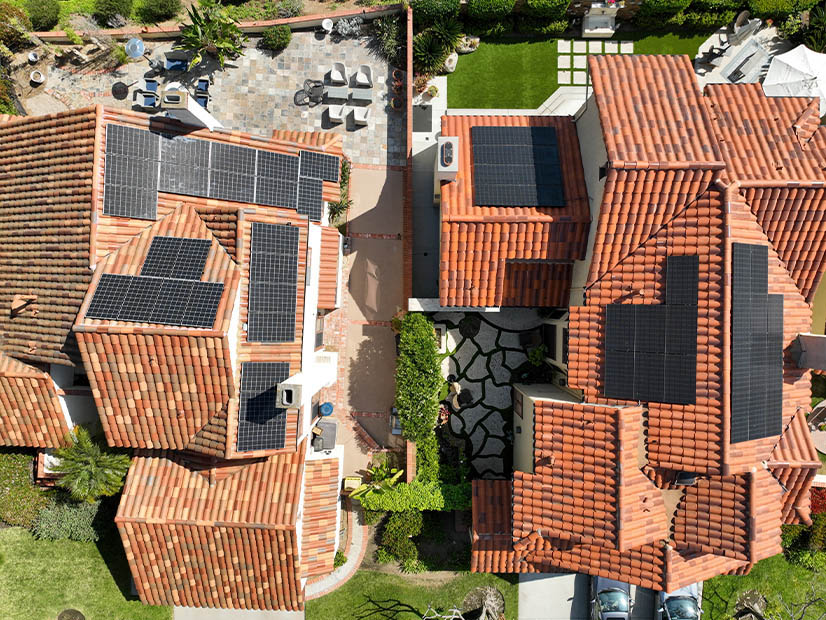The California Public Utilities Commission on Thursday adopted a controversial proposal to revise the state’s net-metering scheme for rooftop solar arrays, including by reducing bill credits for new solar owners and incentivizing battery installations.
“We are launching the solar and storage industry into the future so that it can support the modern grid,” CPUC President Alice Reynolds said in a statement issued after the vote. “The new tariff promotes solar systems and battery storage with a focus on equity and advances the new clean energy technologies we need to meet our climate goals and help ensure grid reliability.”
The vote came after months of wrangling over the plan, which was originally proposed a year ago, then postponed amid public outcry and rewritten to mollify homeowners angry about the possibility of losing their solar subsidies.
The modified proposal, approved by a unanimous vote Thursday, says it tries to balance the “multiple requirements of the Public Utilities Code and the needs of the electric grid, the environment, participating ratepayers, as well as all other ratepayers.”
It will not change the credits paid to current rooftop solar owners for excess electricity they export to the grid. The state’s investor-owned utilities compensate those homeowners at full retail electricity rates, which are much higher than the current costs of utility-scale solar.
The subsidies shift the costs of solar panels from ratepayers who can afford them to those who cannot, Pacific Gas and Electric (NYSE:PCG) and other IOUs argued. The “cost shift” amounts to $3 billion to $4 billion a year, the utilities estimated.
The generous payments to those who install PV panels are credited with making California the nation’s leader in rooftop solar over the past 25 years.
“Since 1997, California has supported the rooftop solar market through its NEM tariffs, which have enabled 1.5 million customers to install more than 12,000 MW of renewable generation,” the CPUC said in a news release last month.
The CPUC’s previous net energy metering proposal, issued in December 2021, would have slashed NEM bill credits by more than half and possibly up to 80%, including for homeowners who installed solar panels prior to the plan’s adoption. (See California PUC Proposes New Net Metering Plan.)
Under the revised plan, future rooftop solar owners will be compensated differently from existing customers through “an improved version of net billing, with a retail export compensation rate aligned with the value that behind-the-meter energy generation systems provide to the grid and retail import rates that encourage electrification and adoption of solar systems paired with storage,” the decision says.
“The successor tariff applies electrification retail import rates, with high differentials between winter off-peak and summer on-peak rates, to new residential solar and storage customers instead of the time-of-use rates in the current tariff,” it says. “The successor tariff also replaces retail rate compensation for exported energy with Avoided Cost Calculator values that vary according to grid needs.”
A fact sheet that accompanied the proposed decision when it was released in November said the new rate structure will encourage customers to install battery storage so they can store solar electricity generated in the daytime and sell it to the grid on hot summer evenings, when prices are higher and the state needs it most for reliability.
Strained grid conditions in the past three summers occurred during heat waves when solar ramped down in the evening but demand remained high from air conditioning use.
The state legislature approved $900 million in funding this year to spur adoption of rooftop solar and battery storage, including $630 million for lower-income households. Those who install solar or solar coupled with storage in the next five years will receive extra payments.
“Customers lock in these extra bill credits for nine years,” the CPUC said in the fact sheet.
The solar industry will benefit by selling more storage along with solar arrays, it said.
The adopted plan removed a controversial provision contained in the December proposal to impose an $8/kWh grid charge on solar customers’ bills, averaging about $48 per month for residential customers.
The CPUC estimated that under the new plan, residential customers installing solar will save an average of $100 a month on their electricity bills, and those installing solar panels and batteries will save $136 a month or more.
“With these savings … customers will fully pay off their solar systems in just nine years or less,” the CPUC said in the fact sheet.



